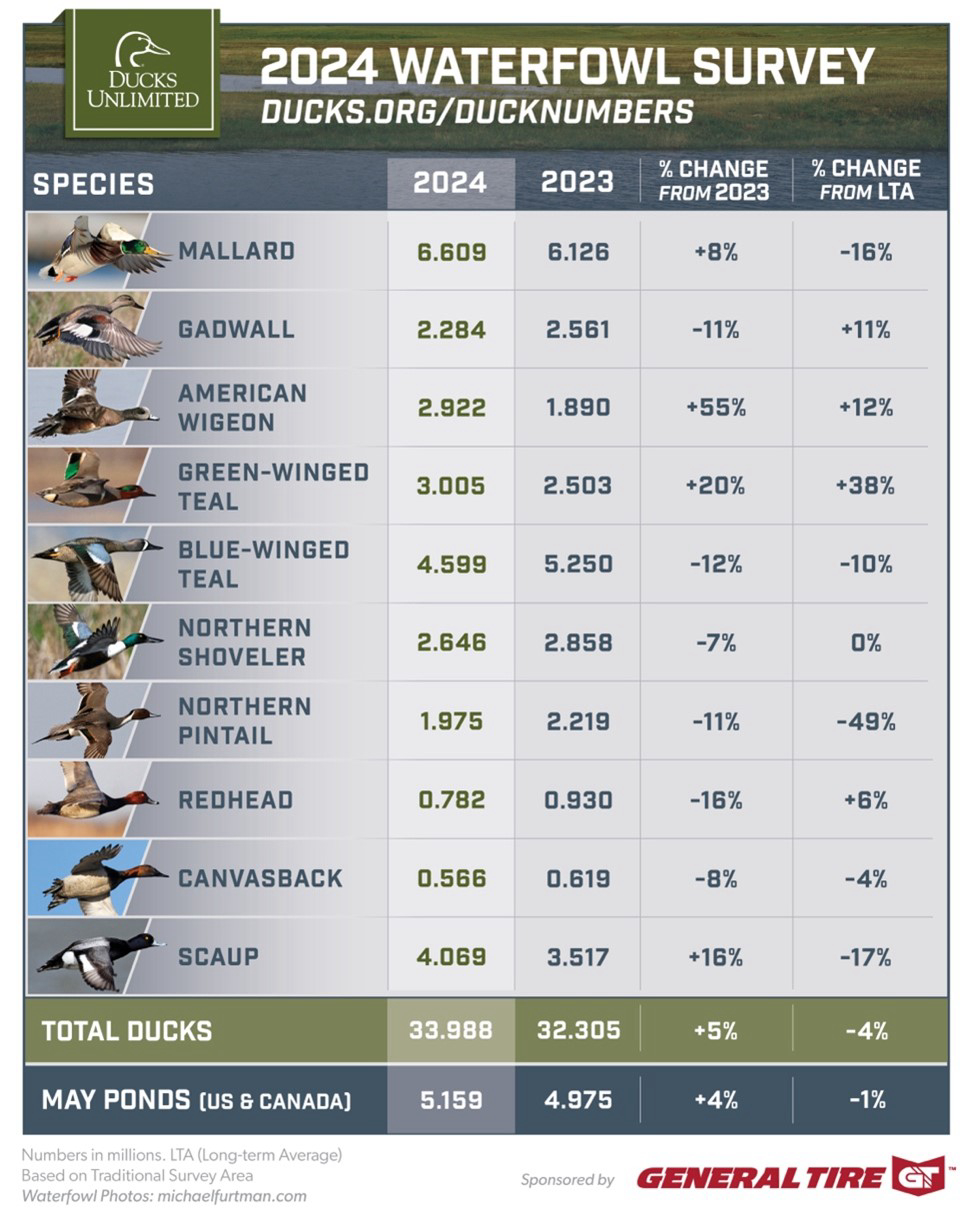Good and Troubling News about Ducks
Bismarck, N.D.–The 56th edition of the Waterfowl Breeding Population and Habitat Survey, released by the U.S. Fish and Wildlife Service and the Canadian Wildlife Service, revealed wetland conditions and duck populations well above their long-term averages.
The headline numbers: The total-duck population across the traditional survey dropped slightly to 40.9 million from last year’s 42 million, mallard numbers were steady at 8.4 million, scaup numbers rose slightly to 4.2 million and the northern pintail population bumped up 9 percent to 3.5 million.
More good news: Most of the breeding grounds are today even wetter–in some cases much wetter–than when the surveys were flown in May, which will promote re-nesting and increase brood survival.
As was the case in 2009, the real news is buried in the fine print, which showed a continuing shift in breeding-duck numbers from Canada to the U.S.
Part of the reason was an all-time record 2.9 million wetlands on the U.S. side of the region, with 2.3 million of those in the eastern Dakotas. Wetlands are what attract nesting ducks. and the U.S. has never been wetter.
Prairie Canada was wetter than normal, led by a 21 percent year-over-year increase in the pond count in southern Saskatchewan. Yet despite being 34 percent wetter than its long-term average, 72 percent fewer pintails and 18 percent fewer mallards settled in Saskatchewan than its historical average.
Once again, the U.S. picked up the slack. More total ducks settled on the U.S. side of the breeding grounds–13.9 million in the Dakotas and eastern Montana as compared to 10.6 million in the prairie portions of Saskatchewan, Alberta and Manitoba. “That’s pretty remarkable when you consider that two-thirds of the Prairie Pothole Region (PPR) exists on the Canadian side of the border,” says Delta Scientific Director Dr. Frank Rohwer of Louisiana State University. “Delta has been saying for years that Canada is broken, and the latest survey numbers once again bear that out.”
The U.S. side of the region attracted 1.4 million pintails compared to just 592,000 in prairie Canada. Last year was the first time ever that more pintails settled in the U.S. than in prairie Canada.
Other stunners included 4.2 million blue-winged teal in the U.S. to 1.9 million in prairie Canada and 3 million mallards in the U.S. to 2.6 million in the prairie provinces.
Under normal conditions, those results would be cause for celebration, but the good news from the U.S. was offset by concerns about ongoing losses of the habitat that attracted those ducks in the first place.
“We heard from a lot of duck hunters who told us the recent season didn’t live up to their expectations after the great wetland conditions last spring,” says Delta Senior Vice President John Devney. “The best explanation is the ducks that settled in the Dakotas and Montana a year ago weren’t as productive as they were in the 1990s because there was a lot less nesting cover than there was in the ’90s.
“The Dakotas have lost close to 2 million acres of grass since 1999–that’s more than 3,100 square miles–and another 2 million acres of CRP are scheduled to expire by 2012.
“Research conducted by the Service showed that upland-nesting ducks need large blocks of grass to produce at population-expanding levels, but we’re losing Conservation Reserve Program (CRP) and native prairie acres at an alarming rate. Not only are we losing grass, but also the high-quality wetlands embedded in those acres.
“The take-home message is that the U.S. side of the region carried Canada during the wet cycle of the 1990s, but if the U.S. keeps losing habitat, who’s going to pick up the slack?”
Rohwer, who is currently involved in research projects in northeastern North Dakota, says nest success in low-grass areas this spring has been extremely poor–less than 5 percent, which is well below what’s necessary for the population to expand. “If we keep losing grass, that doesn’t bode well for duck numbers,” he says.
Waterfowl hunters across the continent have expressed concern about what impact the BP oil spill will have on the estimated 5 million ducks that will begin arriving in the Gulf of Mexico less than two months from now.
“The oil spill is an environmental disaster that could affect ducks and duck hunters for years to come,” says Rohwer. “We have no experience with this kind of disaster, so it’s impossible to predict what will happen.
“It would appear that diving ducks like scaup, canvasbacks and redheads will be most at risk because they sit in the coastal bays where there has been a lot of oil in recent weeks.”
Rohwer says it’s possible large numbers of dabblers could also be affected by oil, but calls that a worst-case scenario and only should occur if a tropical storm pushes oil into the freshwater portions of the marsh where dabbling ducks are typically found. “There’s no way to know if ducks will move around to avoid the oil,” Rohwer says. “Ducks have no experience with oil, so they may have little predisposition to avoid it.
“The bottom line is while we need to find ways to mitigate the damage caused by the Deepwater spill and ensure the long-term viability of coastal wetlands, we can’t ignore the challenges ducks face on the breeding grounds.
“Loss of CRP and native grass in the Dakotas, and the loss of wetlands and low productivity in Canada, are suppressing our fall flights. We need to keep the focus on the breeding grounds.”
Contact:
Delta Waterfowl Senior Vice President John Devney at 888-987-3695






